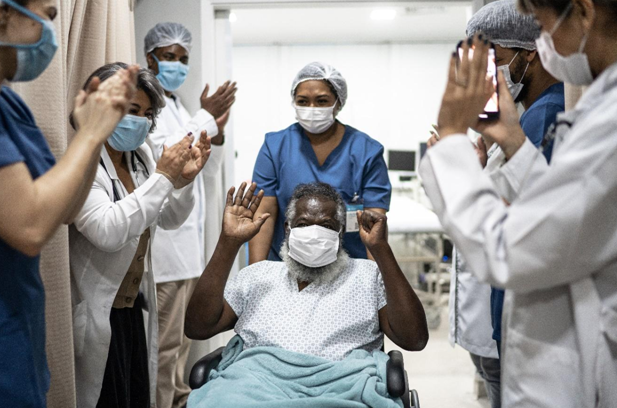How Can Patient Behaviour Affect Decision-making In Healthcare
It is easy to assume that all patients are happy to receive a standard level of care from hospitals and the people who run them. However, healthcare decisions often change depending on how patients conduct themselves!
In some cases, for example, the healthcare a patient receives may reflect their religious beliefs, their willingness to communicate, or even how they choose to respond to recommended steps.
Unfortunately, some patients may find that the healthcare they receive fails to support them – and this is not necessarily the fault of the healthcare provider they’re speaking to.
In this guide, we’ll look at how patient behaviors can change in a medical and pre-treatment setting, why some behavioral patterns can dictate the care they receive, and how healthcare providers can help to support these patients better in the future. In many cases, behavioral patterns are not the patient’s fault!
Table of Contents
What Might Change A Patient’s Behavior?
When we talk about patient behavior, we refer to how a given person reacts to certain news, suggestions made by doctors and nurses, and how they conduct themselves over a treatment period.
Crucially, we need to remember that unless a patient has a power of attorney (POA) arrangement in place, it is doubtful that healthcare systems can force treatments upon people who refuse. The only other time this may change is if, for example, their life is in danger (or other people are at risk). In such scenarios, the police may require involvement.
A patient’s behavior regarding healthcare and treatment may be affected by political or religious beliefs, fear of certain procedures, or even due to some neurological conditions.
In the latter, strategies to help support such patients require a careful approach. Is the patient, for example, of sound mind to agree to specific procedures? Do they have a POA who can speak for them?
Patient behavior can, of course, also change through certain medications, alcohol use, or recreational drugs. It’s up to healthcare professionals to fairly judge each case as it emerges.
The challenge most healthcare providers face is that not all people will willingly accept recommendations or even life-saving care. This can require more transparent communication and negotiation or may even involve the input of loved ones in certain circumstances.
To fully understand how patient behavior affects the healthcare they receive, we need to drill down into a few specific, hypothetical examples.
How Can Patient Behavior Change the Healthcare They Receive?
Ultimately, patient behavior can determine how successful treatments are. The best course of action for most patients is to listen to medical advice and follow it to the letter!
Failure to adapt behavior in line with healthcare suggestions can lead to a delay in treatment or may even lead to a worsening of symptoms. It may even result in expulsion from certain facilities depending on recommended action by the police and state.
To explain this phenomenon more closely, here are some of the more common behavioral drivers that can change the outcome of patient care.
Willingness to Receive Treatment
There are many reasons why patients may not wish to receive medical care. It is not always the case that people want to accept what’s best for them!
A key example from recent years is the anti-vaccine movement. People who believe vaccines cause harm rather than protect them against specific diseases and viruses may become ill.
For example, refusing to take COVID-19 vaccines may result in patients contracting the disease and reacting poorly to its effects. Healthcare providers cannot vaccinate people against their will – a talking point still fueling discussions years after COVID-19 emerged.
In other cases, some people may refuse treatment if they feel suicidal or unworthy of care. In such circumstances, healthcare providers may suggest counseling or psychological care to help support their patients.
Other people may simply be afraid of the medical procedures recommended. For example, a patient recommended for open heart surgery may be scared that they will wake up on the operating table and refuse treatment.
According to medical ethics guidelines in the US, in most cases, medical professionals cannot deliver care to people who refuse it – providing it is for a non-life-threatening illness. This matter has been upheld in previous years by the Supreme Court.
If it is for a life-threatening illness, refusal to comply may lead to patients delaying their recovery, potentially resulting in worsening conditions and even death.
In some cases, ethics dictate that medical professionals should deliver treatment – and we will cover this in a little more detail below.
The bottom line here is that a refusal to accept care can and will worsen conditions and may put patients’ lives at risk. Regrettably, healthcare may be unable to assist in some cases, as per the Supreme Court ruling mentioned above.
Adherence to Recommendations
Falling in a similar line with the point above, some patients may find their recovery from illness, surgery, or otherwise is delayed thanks to a lack of guideline-following. This doesn’t have to be malicious or intentional!
For example, a patient who forgets to take their antibiotics for a skin infection may find their condition worsening, or they relapse and head back to the hospital. This inaction can lead to healthcare providers repeating the same courses of treatment, potentially having to readmit patients for different reasons.
Some patients may also refuse to adjust their lifestyles, which can lead to healthcare needing to exhaust the same services and treatments once over. This may apply to people who are encouraged to lose weight or risk heart disease and strokes, only to relapse after failing to adjust.
The knock-on effect here is that said patients may find themselves in the emergency room, putting extra pressure on nurses, doctors, surgeons, and consultants to help save their lives.
Failure to follow medical recommendations may be malicious or governed by religious beliefs. In this case, some professionals may not be able to deliver the care a patient needs for survival.
Resilience to following care recommendations can change how healthcare providers deliver said care to their patients. Without administering force, some professionals may need to offer clearer guidance to ensure patients take their medication and live healthier. This can mean having to paint a fairly bleak picture in some cases!
Personal Beliefs and Values
Individual beliefs can impact how patients recover from specific conditions and emergencies. A clear example would be through following religious texts. For example, Jehovah’s Witnesses believe God does not want them to receive blood from others.
In the case of a Jehovah’s Witness experiencing huge blood loss from an accident, a patient (and their family) may refuse to accept transfusions that could save their life. These circumstances may force professionals to act depending on the case and how ethics are interpreted.
Following this same example, Jehovah’s Witnesses who need blood transfusions may find themselves choosing religion as a priority because – even if they survive with someone else’s blood – they risk being expelled from their community. Family members, for example, may refuse to speak to people who willingly accept blood transfusions – even if they are close.
In cases of religion preventing patients from receiving the care they need; medical professionals may need to work with community leaders to help find resolutions. For example, a Jewish person refusing care on religious grounds may benefit from mediation via a Rabbi.
Otherwise, it’s down to the medical professional to explain the ramifications of inaction in detail. It’s a dilemma that is often complex and fairly common.
Communication Breakdowns
In some cases, patients may not understand the care options provided to them, which can lead to angry or frustrated responses. In these cases, the healthcare professional’s job is to help patients understand what is at stake as clearly as possible.
Where consent is required for surgery or even for a simple examination, professionals may need to paint stark pictures of what could happen if care isn’t available. For example, patients experiencing early-stage lung cancer may benefit from advice about what happens if they continue smoking.
Communication breakdown at this level may tie into discomfort and denial. Patients may refuse to listen to advice or try to understand what is at stake because they are in denial about their mortality and may feel uncomfortable facing it.
However, communication problems may arise if the information is too complex for patients to understand. It’s important for healthcare providers at all levels to adapt the information they provide so that their patients can take any action they need to.
Some patients, for example, may have learning difficulties and need additional support in helping to follow treatment plans or even understand the ramifications of surgery or treatment that lies ahead. In these circumstances, providers may need to communicate with family members and other specialists to help people adjust to what lies ahead.
Communication breakdowns through intentional behavior or refusal to cooperate will fall to ethical measures. These may vary from facility to facility and from state to state. If a patient is willfully avoiding treatment but is putting their life at risk, a doctor, nurse, or other professional will need to make a difficult decision.
Attitudes Toward Medical Care
As mentioned, some patients may be resistant to medical care, period. Some may not be hostile to having this approach. For example, they may believe holistic or natural treatments are more effective than care provided in a hospital or by a nurse.
Some patients may also choose their own daily nourishment schedules, which they feel reluctant to change.
Attitude toward medicine ties in with religious beliefs influencing patient behaviors. It’s not the job of a healthcare provider to change a patient’s beliefs, nor to force them into decisions they may find uncomfortable. However, they must follow the same code of ethics to decide which route is likely to cause the most beneficial results for the patient.
It’s impossible for healthcare providers to fully influence a patient’s beliefs or attitudes toward medical care. They may, for example, have had a traumatic experience through surgery or general medical care, which influences their behavior.
What healthcare providers can do, however, is adapt what they offer to be as flexible around their patients as possible. We’ll explore this in a little more detail below.
What Are The Risks of Patient Behavior Affecting Healthcare Decisions?
The risks of patient behaviors impacting healthcare may prevent their ability to recover from specific conditions, surgeries, or otherwise. Behavioral barriers may also provide family members and loved ones with additional stress and trauma, depending entirely on the circumstances.
However, patient behavior can also have devastating knock-on effects on how healthcare is provided. Another key example arrives from the height of the COVID-19 pandemic. Those patients who refused vaccinations or would not follow mandated mask or lockdown guidelines may have contributed to increased hospital demands.
Studies over the height of the coronavirus outbreak indicate that many people in hospitals receiving ventilator treatments were unvaccinated. This meant that many medical resources were stretched to breaking point, resulting in poor standards of care and target-hitting across the board.
Patient behavior can prevent doctors and nurses from treating other people within reasonable delays. This means that innocent people suffering from other conditions may be at the mercy of the behavior of other people.
There is no humane way to police how people behave. Instead, it’s down to the medical provider, already under immense pressure, to adapt to each case. How long does it take to become a nurse practitioner and learn to deal with all these challenges? Years in many cases – but Carson Newman University’s online courses can help kickstart the journey quickly.
How Can Healthcare Adapt Better to Patient Behavior?
When treating patients, all healthcare providers must take an important step to review documentation and procedures to ensure that patients receive clarity to understand what is happening and the next choices.
Communication breakdown can lead to trigger behavioral responses that, as explored above, create more pressure and pain for other people. The professionals who work at hospitals and surgeries, too, must be ready to make life-changing decisions at a heartbeat’s notice. Otherwise, care delays and even rising mortality rates may occur.
Healthcare providers should always treat each patient individually. As many people will know, no two patients are ever the same! While they may share conditions, some respond better to treatments than others. There is also no guarantee of how a patient will react to specific news or guidance or even if they will understand what is at stake.
Providers may also use technology to better effect to help inform and engage with their patients. Social media, for example, is a powerful tool in helping to deliver important messages, again drawing from the COVID-19 pandemic. Important information regarding vaccines can be delivered widely through online portals.
Providers can also offer patients a great deal of control via apps and telehealth services. In some cases, patients may not need to return to hospital settings for repeat consultations. They may be able to check in with doctors from afar through video links.
They may also be able to track lifestyle adjustments easily using mobile apps. There is a wealth of options, for instance, for newly diabetic people to download and use to help track their blood sugar. Alongside following lifestyle adjustments and potential injections, people with diabetes may find it easy to manage their care autonomously with technology.
Healthcare providers need to focus on convenience to help quell specific behaviours in patients. Many people are scared of hospitals and physical exams simply because they are uncomfortable or do not understand what will happen.
By providing clear information and making medical procedures as convenient as possible for patients, providers can lower the risk of detrimental behaviour getting in the way of treatment and recovery. This, of course, will require funding and lots of planning!
Conclusion
Patient behaviour is a variable that’s perhaps one of the biggest “unknowns” in modern healthcare. While providers know how to treat and manage various conditions and cases, there’s no real way of predicting how any given patient will behave when it comes to consultation and treatment.
Therefore, doctors, nurses, and other professionals must always remember their training and ethical foundations. Some cases where behaviour can get in the way of treatment may delay care or impair treatment effectiveness. Therefore, it’s up to any given professional to think on their feet and find an ethical solution.
Patients benefit from clear instructions and a broad knowledge of what’s at stake. Unfortunately, healthcare providers can’t always guarantee what people will and won’t read! Therefore, flexibility on their part is vital.
That’s always going to come at a cost. But, with more and more people joining the nursing profession and showing incredible aptitude, there are blue skies ahead for healthcare providers – and the people who need them the most.







